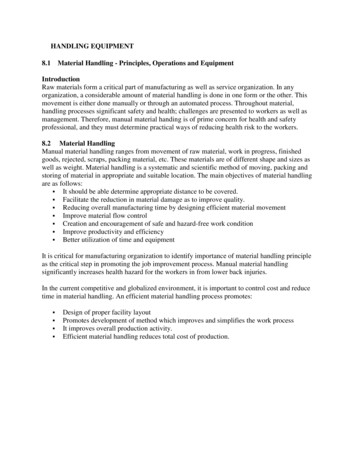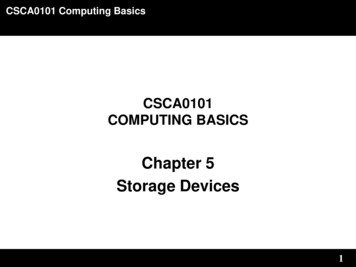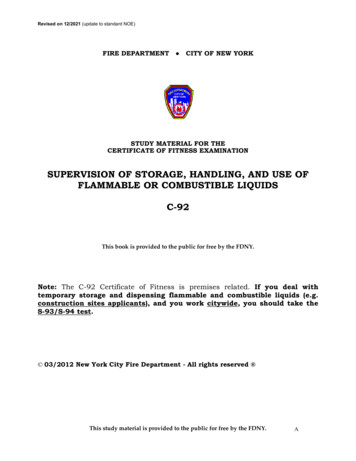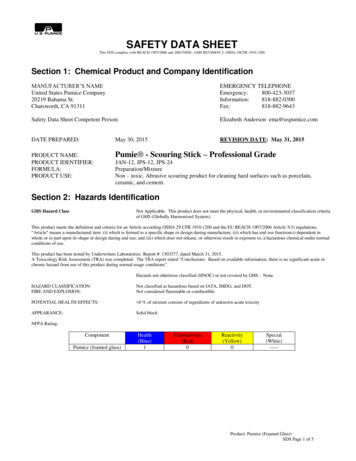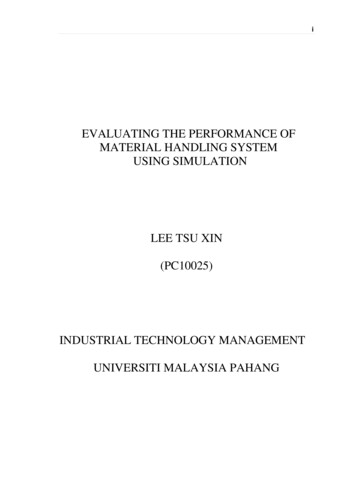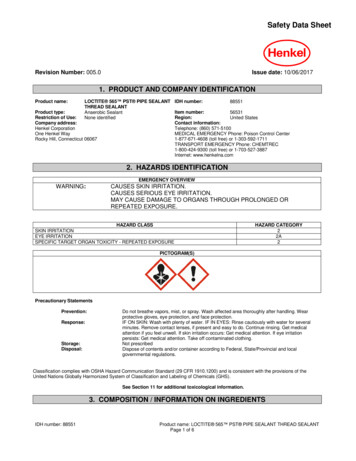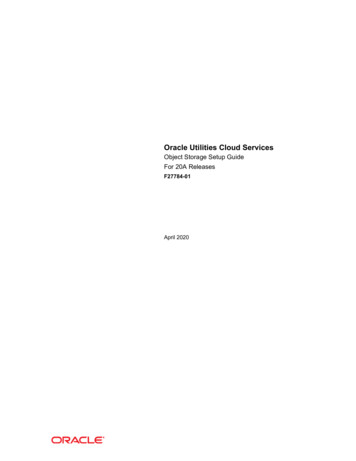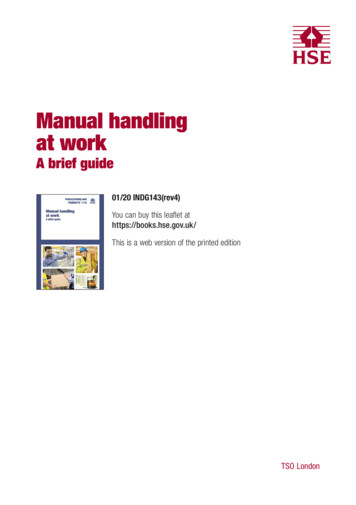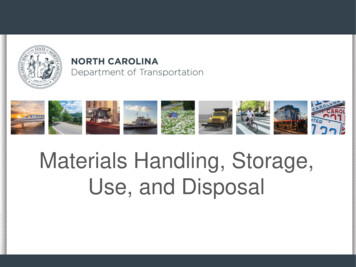
Transcription
Materials Handling, Storage,Use, and Disposal
Materials Handling, Storage, Use,and Disposal Lesson Overview– Types of material handling equipment.– Hazards associated with materialhandling activities– Prevention of hazards associated withmaterial handling equipment– Employer requirements to protectworkers from material handling hazards
Types of EquipmentConveyorsSource: OSHAPoweredIndustrial TrucksSource: TEEX-Harwood
Types of EquipmentCranesSlingsSource: OSHASource: OSHA
Factors Contributing to Injuries Weight and bulkiness of objects Bending, twisting, turning movements
Hazards Improper operation of equipment Accumulated materials or clutter
Hazards Unsafe conditions of materials orcontainers Flammability or toxicity of somematerials
Hazards Weight of materials Binding ties or otherdevices that securebundles orbound materials
Hazards Falling objects Lifting, pushing, pulling, or otherwisemanually moving large, heavy items
Hazards Improperly stacked materials Struck-by or caught-in/-between hazards
Injuries Types of injuries commonly reported– Sprains, strains, tears– Soreness and pain– Bruises and contusions– Cuts, lacerations, andpunctures
Injuries Examples of events orexposures leading toinjuries– Contact with objectsand equipmentSource: OSHA– Transportation incidents– Exposure to harmful substancesor environmentsSource: OSHA
Injuries– Falls, slips, trips, orloss of balance– Repetitive motionSource: OSHA– OverexertionSource: OSHA
Preventing Hazards Moving materials manually– Use devices to assist withholding loads– Wear PPE– Use proper lifting technique– Seek help for oversized loads
Preventing Hazards Cranes– Major types of crane accidents Contact with power linesOverturnsFallsMechanical failureSource: OSHA
Preventing Hazards– Hoisting tons of material, steel,and concrete with cranes– Operated only bythoroughly trainedand competent workersSource: OSHASource: TEEX - Harwood
Preventing Hazards– Eliminate/reduce cranehazards by: Knowing– Load– Capacity of the crane– When the load is safe to lift Always checking craneload chart and neverexceed load limitsSource: TEEX - Harwood
Preventing Hazards Inspection of crane by a qualified person––––Modified, repaired, or adjustedPost-assemblyAt least every 12 monthsEquipment not in regular use Visual inspection by acompetent person– Prior to each shift– MonthlySource: OSHA
Preventing Hazards Slings– Connect a crane hook to a load– Proper selection– InspectionSource of photos: OSHA
Preventing Hazards– Reduce sling hazards by: Lubricated Do not shorten with knots,bolts, or other devices,or kink legs Keep clear of loads Avoid sudden movementSource: OSHASource: OSHA
Preventing Hazards Forklifts– Main causes of injuries Forklift overturnsForklift striking workers on footPersons crushed by forkliftsPersons falling from forkliftsSource: OSHA
Preventing Hazards– Illegal forklift operators Anyone under 18 Anyone not properly trained and certified
Preventing Hazards– Driving the forklift Obstructed vision Travel path Approaching people Elevated platform Seat belts and ROPS Raising/lowering forks Safe distance
Preventing Hazards– Elevating workers with forklift Standing on forksLifting personnelApproved lift platformRestraining means
Preventing Hazards– Driving forklift on Grades/Ramps Use extreme cautionNo turnsTilting and raising loadPoint load up the inclineSource of photos: OSHA
Preventing Hazards– Forklift operating speed Tip-oversTurningAvoiding collisionsWet and slippery floorsAscending/descendingObstructed visionSource of photos: OSHA
Preventing HazardsAvoiding Excess Weight Do not exceed weight capacityof forklift. Center loads and secure tokeep from shifting to maintainbalance of weight
Preventing Hazards– Use of Dock Boards forLoading/Uploading Bridging space Securing portable dock boards Handholds for dock boardsSource: OSHA
Preventing Hazards– Exiting the Forklift Set brake, lower forks/liftingcarriage, neutralize controls Stand-up type forklift– Riding the forklift No passengers allowed Exception – seat is providedSource of photos: OSHA
Preventing Hazards– Avoiding Struck-by/Crushed-by Don’t jump from an overturning, sit-down typeforklift. Stay with the truck, hold on firmly, andlean in the opposite direction of the overturn.Source: OSHA
Preventing Hazards– Forklift Training – do not operate a forkliftwithout proper training and licensing.– Reporting Damage – any damage orproblems that occur to a forklift during ashift should be reported to the supervisor.Source: OSHA
Preventing Hazards Earth-Moving Equipment– Scrapers– Loaders– Crawlers– Bulldozers– Off-highway trucks– Graders– TractorsSource of photos: TEEX - Harwood
Preventing Hazards Earth-Moving Equipment– Seatbelts– Reverse gear not used unlessthat piece of equipment has: Back-up signal alarm or Signaler– Operator properly trainedSource: OSHA
Employer Requirements Comply with OSHA standards relatedto materials handling, including:– Training requirements, includingrequirements for forklift training.– Inspection requirementsSource of photos: OSHA
Employer Requirements Comply with manufacturers’requirements and recommendationsfor materials handling equipment.
Recognizing HazardsIdentify potential hazards and possible solutions:
Recognizing HazardsIdentify potential hazards and possible solutions:
What three steps need to takeplace before an employee mayoperate any piece of mobileequipment?1. Class room instruction and writtentest2. Equipment overview and hands-on3. Final operational evaluation
Why do we fill out pre-operationinspection sheets?1. Keep up withequipmentmaintenance2. Ensure equipmentis safe to operate3. Compliance
Are cell phones, earphones, etc.allowed to be used while operatingmobile equipment?
What rule or method must be usedwhen mounting and dismountingmobile equipment?3 Points of Contact
What is the proper way to dismount askid steer?
What must be in place before placingany piece of mobile equipment intomotion?
Does a skid steer’s lap bar take theplace of the seatbelt? No, the seat beltmust always beworn with the lapbar.
What are the steps to safely enter a trailerwith a piece of mobile equipment?1. Make sure brakes are set.2. Chock trailer wheels3. Jack stand in place if the truck is notconnected4. Check condition of floor/sides5. Dock plate is secure6. Secure keys from driver, dock lock, etc.
When is a piece of mobile equipmentconsidered unattended?1. Operator is more than 25 feetawayOr2. Piece of equipment is out of theoperators sight
What piece of mobile equipment is theexception to the unattended rule?Why?
When can a piece of equipment exceedits rated capacity?NEVER
Where can the rated capacities befound?
What direction does a loaded piece ofequipment always need to face on aslope? Loaded forks or bucketneed to face UP the slopeat all times. Never attempt to turn ona slope.
Why do we carry loads as close to theground as possible? Center ofgravity and thestabilitytriangle.
Who is responsible for pedestrian safetyaround mobile equipment? Ultimately the operator, butpedestrians have responsibility too. “10 foot rule”
How many employees are needed tosafely complete rail movements? Min. of Two. ALWAYS work in pairswhen operating railequipment. There should be oneconductor (switchman)and one engineer.
Is it safe to walk or stand on the tracks? No, it is never safe to walk or stand in the “lineof fire” or in the gauge.
How far should you be from the end of arailcar before crossing?
Is it acceptable to set a hand brake fromthe ground? No, hand brakesmust be set fromthe brake platform. Reduces risk ofback strain andstanding in front ofrailcars.
Where should the spotter be standingwhile coupling cars? 3’ off the side ofthe tracks. Never authorizemovement untilcompletely clear. Never reach in tomake last secondadjustments toknuckle.
Questions?
Materials Handling, Storage, Use, and Disposal Lesson Overview -Types of material handling equipment. -Hazards associated with material handling activities -Prevention of hazards associated with material handling equipment -Employer requirements to protect workers from material handling hazards
